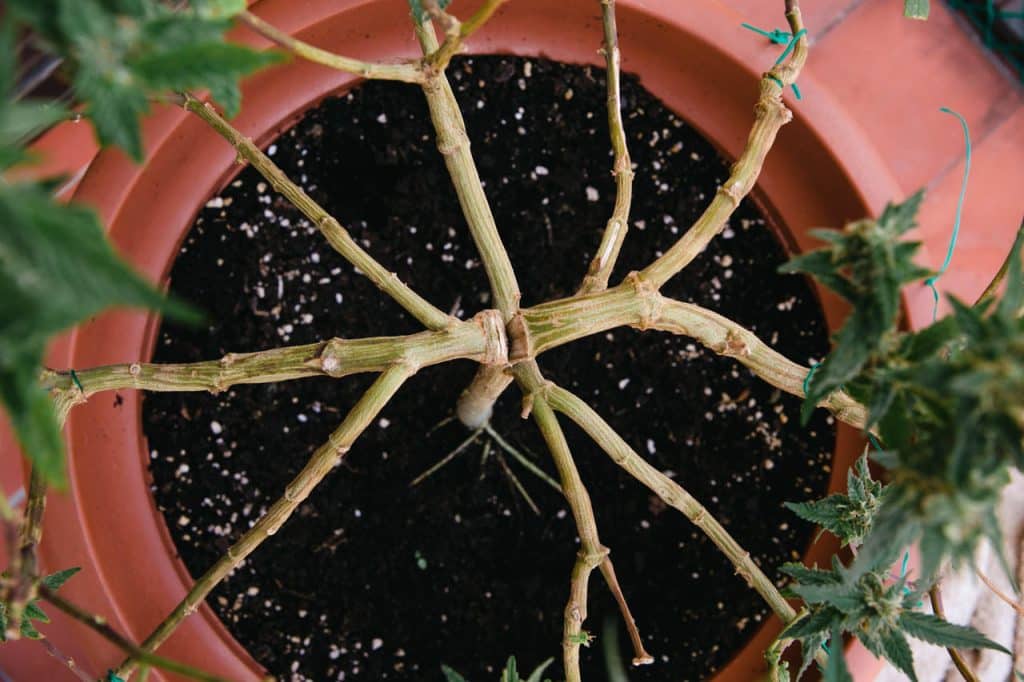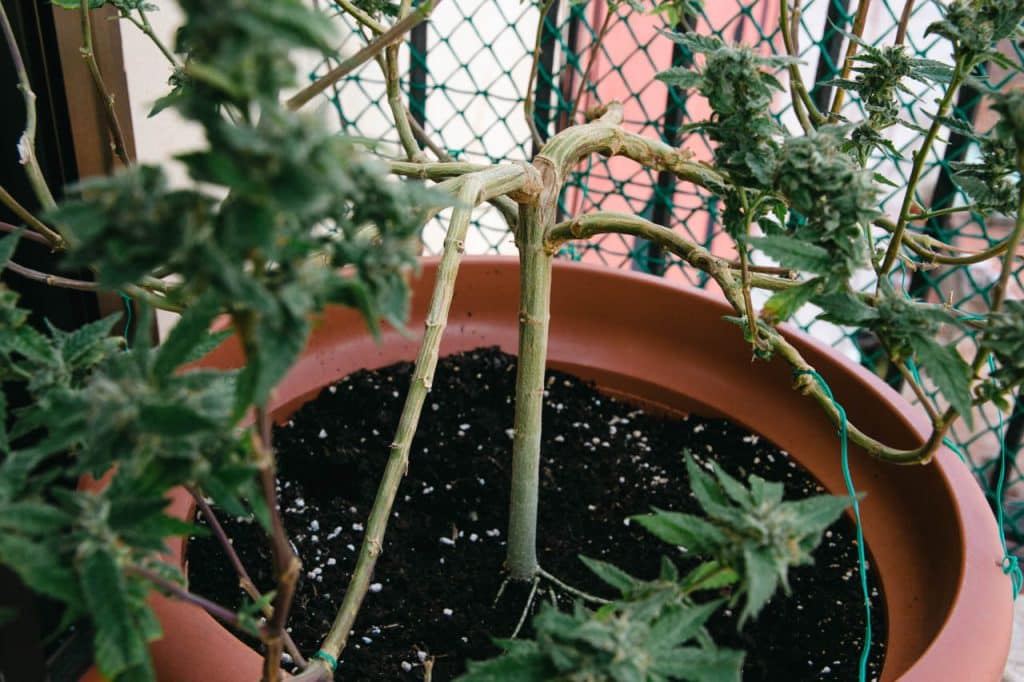Free Tropical Runtz seeds on orders over $150!
Every gardener’s objective is to raise the total productivity of their cannabis plants, which is why there are so many different cannabis plant training strategies. Manifolding is a typical technique used by many gardeners. Additionally, a cannabis manifold is a very effective method of training plants to produce enormous quantities of the most attractive bud.
Manifolding is a plant training strategy that stimulates many bud locations in your cannabis. The procedure entails developing a cannabis manifold, a branch structure generated by repeatedly topping your plants. Topping is closely linked to manifolding since it is required to achieve the distinctive branch arrangement for which this crop training technique is known.

Topping your cannabis plants entails removing the apical bud, the uppermost growth. To achieve the most outstanding results while manifolding, you must repeat this process at least 2-3 times, which is where many of the worries about manifolding come from. Cannabis might respond poorly to pruning and get stressed since it includes removing valuable plant materials they may require to thrive.
Manifold and mainline training techniques are both for producing plants with eight main branches or colas. To create eight equal main branches or “colas,” the plant is topped three times at symmetrical nodes. Manifold training creates eight primary branches with just two tops by retaining four branches on each side of the cannabis plant during the second topping.
Manifolding is one of the most dependable means of generating improved yields from your cannabis plants. It fosters robust vegetative development and increases the number of bud sites on your crops through a straightforward step-by-step approach that requires topping and training. Harvesting manifold plants will yield at least 40% more than harvesting regular-grown cannabis. It also helps that manifolding isn’t as dangerous as some people make it out to be, although it is a high-stress training technique. There will be no losses if you complete the steps correctly and pick the correct strain for the manifold.
Another advantage of manifolding is that it improves plant ventilation, which is critical for cannabis, particularly its buds. Having better-ventilated plants prevents mold and other fungal infections from tainting your crops. Bud rot and other cannabis illnesses are also less likely to emerge on your plants. Furthermore, because there is less plant material to dry and the buds dry more uniformly, manifold plants are less vulnerable to mold during the drying and curing process. Manifolding improves the safety, ease, and speed of the post-harvest process.
Cannabis manifolding facilitates the complete harvest. You would also follow the directions for simple harvesting while cultivating manifold cannabis. Pruning and defoliating are crucial phases in the manifolding of cannabis. When your cannabis crops are ready to be harvested, you won’t have any trouble pruning them because there won’t be much foliage to remove. You spare yourself the difficult chore of cutting your buds by straining yourself during the growing phase, including pruning and defoliating your plants.
Manifolding is a straightforward form of plant training when compared to other approaches. It consists of two steps: topping and training. Topping is a simple process that entails removing the apical bud of your plants to facilitate lateral branch development. Meanwhile, training your plants entails urging them to grow in a specific direction. It is essential to ensure that your primary stems grow outwards rather than upwards while manifolding. These two processes are straightforward since there are no “judgment calls” on how and when to do them.
You’ll need two items before you can multiply your plants. The first is high-quality grow lights. Small LEDs and fluorescent lights will not suffice since they are insufficiently powerful to penetrate and provide sufficient light to your plants. Instead, use metal halide, high-pressure sodium, or a light-emitting ceramic system (LEC). The second factor is space. When you manifold the cannabis plants, you spread out the main branches to provide them equal quantities of light while avoiding overpopulation. You’d need a lot of space in your indoor garden for this. Other tools required are;
Manifolding is a time-consuming and repetitive procedure, some of which you may overlook or do incorrectly.

Here’s how to appropriately manifold your plants.
To begin the manifolding procedure, you must first top your plants. But first, before you top your plants, ensure they have at least 5-6 nodes. You want to have adequate branches after you top your plants since proper topping necessitates removing the upper growth of your plant beginning at the third node.
After you’ve finished topping your plants, use the soft garden ties to secure the main branches. Stakes can be used as anchors, or if using a training pot, fasten the ties to the holes on the rim.
Top the cannabis plant once the two branches have developed into new main stems. Remove any unwanted growths after topping by defoliating and trimming. The foliage under the manifold and big fan leaves are examples of needless growth.
Before you begin blooming, train the branches of the plants to spread outwards so that all of the colas on your manifold cannabis receive equal quantities of light. It is also a method of avoiding overpopulation. Once your plants have reached the correct height and spacing, you may turn on the light cycle in your indoor garden to begin flowering.
When your plants reach the blooming stage, they are no longer concerned with creating new leaves; therefore, you should avoid over-pruning them. It is, nevertheless, vital to defoliate and trim your plants so that foliage such as substantial fan leaves do not obstruct your buds.
The final step is removing any vast fan leaves obscuring your buds. While this may appear excessive, it is necessary to ensure that your buds receive adequate light and good air circulation.
When your plants have 5-6 nodes, it is time to manifold them. You can guarantee that your plants recover rapidly after being top in this manner. If you top your plants too soon, you may inhibit their development. Another reason for waiting till your cannabis plants have enough nodes is to ensure you have adequate leaves. To construct a manifold, you must remove the plant’s uppermost growths, which is everything starting from the third node. Furthermore, waiting until your plant has developed enough nodes ensures that the leftover branches develop sufficiently to produce new main stems after the plant is topped.
Although it is feasible to manifold autoflowers, professionals do not recommend it. Time is one of the most critical aspects of manifolding. All high-stress plant training methods need a recovery interval, which autoflower strains, because of their short growing time, lack. Another crucial aspect of manifolding is selecting healthy and vigorous plants. While autoflowers tolerate unexpected temperature changes well, the same cannot be accurate for topping them. Pruning causes most autoflowers to blossom prematurely as a reaction to stress.
It is. Manifolding has specific directions to follow and does not rely on intuition or experience. However, if you are new to manifolding, you should first undertake low-stress training (LST). Because manifolding is sometimes regarded as an LST, it will help you get the necessary experience.
There is one thing that every high-stress plant training has in common. The first thing is that they tend to add a week or two to the growing time of your plants. Your cannabis needs time to recuperate, which means prolonging the vegetatve stage of the plants by either maintaining a 16/8 light/dark cycle or selecting a strain with a longer vegging duration. Manifolding is time-consuming and, at times, tiresome, increasing the growing time of your plants. The last disadvantage of manifolding is that it generates stress, like all plant training procedures involving trimming. Of course, this stress is beneficial since it causes your plants to develop more aggressively in reaction to the stress. However, this might backfire if you choose to multiply plants that can’t tolerate too much stress or plants that are weak after an occurrence (either recovering from infestation or disease).
Manifolding is a high-stress plant training method that allows your cannabis plants to produce more. It’s one of the few plant training techniques used on autoflowers (as long as you choose the right strain). However, selecting the optimal strain for manifolding should not be limited to autoflowers. When planning to produce plants for training, evaluate the strain and only choose the finest grade genetics.





Offers
This product is not for use by or sale to persons under the age of 18. This product should be used only as directed on the label. It should not be used if you are pregnant or nursing. Consult with a physician before use if you have a serious medical condition or use prescription medications. A doctor’s advice should be sought before using any hemp products. All trademarks and copyrights are property of their respective owners and not affiliated with nor do they endorse this product. These statements have not been evaluated by the FDA. This product is not intended to diagnose, treat, cure or prevent any disease. By using this site you agree to follow the Privacy Policy and all Terms & Conditions printed on this site. All products contain less than 0.3% Cannabinoid-compliant with applicable Federal Laws. Please make yourself aware of any and all applicable laws regarding hemp in your jurisdiction. Premium Cultivars accepts no liability or responsibility regarding germination laws in any specific locale state or national jurisdictions.THCA products are not available for shipment to the following states: Hawaii, Idaho, Minnesota, Oregon, Rhode Island, Utah, Vermont *Note: Products with Total THC content above 0.3% must not be shipped to these states.
We want to help you get your hands on the seeds you want, take 20% off your next purchase when you enter your email below!
We want to help you get your hands on the seeds you want, take 20% off your next purchase when you enter your email below!